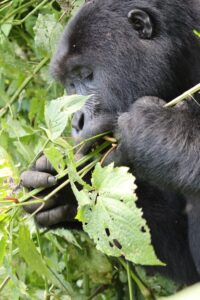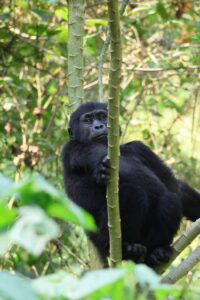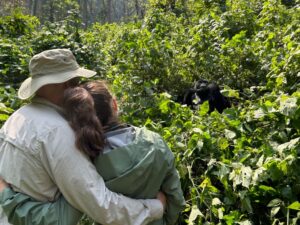Lembro-me de, quando criança, no final dos anos 80, ter chorado rios de lágrimas depois de assistir a um filme. Gorilas na Névoa, que conta a história da vida da Dra. Dian Fossey e sua luta para salvar os últimos gorilas-das-montanhas que viviam entre Ruanda e o que era então o Zaire. Uma luta que acabou lhe custando a vida em um caso de assassinato não resolvido até hoje. Naquela época, restavam apenas 220 gorilas-das-montanhas selvagens na região, e a batalha para protegê-los contra caçadores furtivos e a destruição completa de seu habitat parecia impossível de vencer.
Agora, a população cresceu para mais de mil gorilas vivendo entre Ruanda, Uganda e a República Democrática do Congo. Provavelmente, nem nos sonhos mais ousados de Dian ela imaginaria que isso fosse possível. Como, apesar de todo o histórico recente de conflitos na região, podemos agora ver uma população próspera de gorilas?

Fui um dos poucos sortudos a vivenciar a oportunidade única e cara de rastrear gorilas. Entre as opções disponíveis hoje, escolhemos a rota intermediária pelo lado ugandense do Parque Nacional dos Vulcões. Viajantes de luxo geralmente partem de Ruanda, onde podem se hospedar em lodges cinco estrelas, enquanto mochileiros mais aventureiros optam pela rota mais barata e desafiadora através da República Democrática do Congo, devastada pela guerra. Começamos na cidade de Kisoro, em Uganda, hospedando-nos no histórico Traveler's Lodge, onde Dian Fossey e outros pioneiros da pesquisa de gorilas se hospedaram. A subida pelas montanhas serve como um lembrete de quão perto chegamos de dizimar completamente o habitat dos gorilas. É um cenário dramático de desmatamento desde Kisoro até o que é...Agora, o Parque Nacional da Floresta Impenetrável de Bwindi. A bela e exuberante floresta deu lugar a vocêCampos improdutivos em colinas íngremes demais para cultivar qualquer coisa além de eucaliptos esguios.
 Nas fronteiras do parque, as comunidades agora dependem do turismo de observação de gorilas, desde as mulheres que realizam danças tradicionais para receber os turistas, até os mercados de artesanato que vendem pequenas estátuas de gorilas esculpidas, passando pelos carregadores e guias que acompanham os turistas até as montanhas em busca de famílias de gorilas habituadas à presença humana. Lembro-me de cenas do filme em que Dian Fossey abraça filhotes de gorila, mas minhas expectativas estavam mais alinhadas com outras experiências de safári — onde você chega perto, mas não tão perto. Depois de uma hora e meia caminhando pela floresta, encontramos os rastreadores que haviam localizado a família de gorilas que nos foi designada para visitar. Toda a operação turística é altamente organizada, com grupos de até oito turistas visitando famílias específicas de gorilas que são rastreadas e protegidas por guardas florestais.
Nas fronteiras do parque, as comunidades agora dependem do turismo de observação de gorilas, desde as mulheres que realizam danças tradicionais para receber os turistas, até os mercados de artesanato que vendem pequenas estátuas de gorilas esculpidas, passando pelos carregadores e guias que acompanham os turistas até as montanhas em busca de famílias de gorilas habituadas à presença humana. Lembro-me de cenas do filme em que Dian Fossey abraça filhotes de gorila, mas minhas expectativas estavam mais alinhadas com outras experiências de safári — onde você chega perto, mas não tão perto. Depois de uma hora e meia caminhando pela floresta, encontramos os rastreadores que haviam localizado a família de gorilas que nos foi designada para visitar. Toda a operação turística é altamente organizada, com grupos de até oito turistas visitando famílias específicas de gorilas que são rastreadas e protegidas por guardas florestais.

Avistar seu primeiro gorila é uma experiência emocionante. Encontramos nossa família perto de um rio, em uma colina coberta de arbustos frondosos e brotos jovens, seu alimento favorito. Conforme nos aproximávamos, fiquei surpreso com o olhar do gorila-prateado. Parecia que ele estava nos dando permissão para nos juntarmos ao almoço da família. O resto do grupo seguia com suas atividades, nos ignorando. À medida que nos aproximávamos, percebemos o quão relaxada a família de gorilas estava em nossa presença. Um dos gorilas-de-costas-pretas até decidiu que era um bom momento para um momento íntimo com uma fêmea, apesar da plateia humana abafar o riso. Quando terminaram, o gorila-de-costas-pretas sentou-se na colina, observando-nos com um olhar confiante enquanto mastigava um talo. Como o guarda florestal explicou, embora ele seja um filhote de gorila-de-costas-pretas, ser filho do gorila-prateado lhe dá a liberdade de acasalar sem ser desafiado pelo macho dominante.

É uma experiência surreal. Embora pudessem facilmente quebrar o pescoço de um humano com uma única investida, parece que os gorilas entendem que permitir que humanos os observem por uma hora por dia é o preço que pagam para viver livres em seu reino nas montanhas. Nem mesmo o general humano mais inteligente poderia ter concebido e executado um plano tão genial. Conforme foram caçados até quase a extinção na década de 80, seus instintos naturais pareciam lhes dizer que permitir que humanos não ameaçadores se aproximassem era mais inteligente do que lutar contra eles até o último macaco — um caminho que a chamada espécie humana superior provavelmente teria trilhado.

Hoje em dia, observar gorilas está na lista de desejos de tanta gente que governos e comunidades locais lucram mais com o turismo do que jamais lucraram destruindo florestas ou caçando gorilas. Ao contrário de outros animais que já vi na natureza, grandes o suficiente para esmagar um humano em segundos, os gorilas permitem que você chegue tão perto que eles podem olhar você profundamente nos olhos, quase como iguais. Exceto pela exibição ocasional do macho dominante, lembrando-nos quem manda na montanha, ou por um filhote curioso se aproximando para tocar um humano desajeitado e vestido, a experiência é de pura presença e tranquilidade. Com batalhões de guardas florestais protegendo seu habitat e governos trabalhando para manter o fluxo de turistas e seus dólares, os gorilas agora simplesmente desfrutam de sua floresta nublada e continuam a ter muitos filhotes. É irônico que a sobrevivência de uma espécie na natureza dependa da visita de humanos, mas não há dúvida de que essa experiência tem um impacto muito maior na conservação da vida selvagem do que nossos zoológicos antiquados.

O sonho de conservação da Dra. Dian tornou-se realidade graças ao dinheiro do turismo. Os benefícios se estendem não apenas aos gorilas, mas também a todas as espécies que compartilham seu habitat na floresta nublada. Milagres na conservação parecem possíveis quando os turistas direcionam seu dinheiro da maneira correta. Talvez, se mais de nós planejássemos nossas férias para vivenciar outras formas de existência, seja com nossos primos animais ou com culturas humanas ameaçadas pela massificação, o turismo pudesse impulsionar a regeneração. O desafio, é claro, reside em fazer isso de forma equilibrada e sustentável. Embora a grande maioria dos turistas ainda busque gratificação instantânea para escapar da correria do dia a dia — postando fotos no Instagram de alguma praia ensolarada do Mediterrâneo com um drinque na mão —, é evidente que, mesmo no Instagram, há uma mudança em direção a turistas e viajantes que buscam jornadas mais profundas e significativas. A África tem muito a oferecer.

Para uma experiência educacional totalmente imersiva em Uganda, fique atento ao próximo Impact Safari da Small Giants Academy: https://www.smallgiants.com.au/impact-safaris
Para viajar para a África com uma operadora que realmente entende de turismo regenerativo, confira as ofertas da Raw Africa: https://rawafricaecotours.com/
Créditos da foto: Ananda Coutinho
